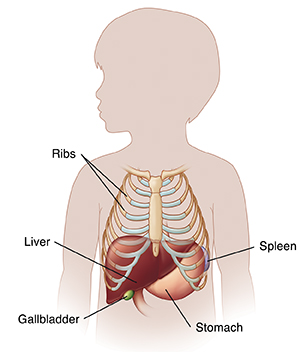When Your Child Has Biliary Atresia
The liver makes a substance called bile. It helps with digestion of food and helps carry waste out of the liver. Bile drains out of the liver through tubes called bile ducts. These ducts carry bile to the first part of the small intestine (duodenum). If a child has biliary atresia, it means that some or all of their bile ducts are damaged, didn't form correctly, or are missing. As a result, bile can’t drain from the liver as it should.

 |
| This picture shows normal bile ducts. Your child’s healthcare provider can point out the area affected by biliary atresia. |
What causes biliary atresia?
Biliary atresia is a congenital condition. This means that babies are born with it. Healthcare providers aren't sure what causes it.
Symptoms of biliary atresia
Some babies have signs of biliary atresia at birth or within the first 2 weeks of life. In other babies, signs don’t appear until around 2 to 8 weeks of age. These signs include:
-
Yellowing of the skin and whites of the eyes (jaundice). Jaundice also causes dark urine and light-colored stools. It's caused by a buildup of bilirubin, a yellow substance made when the body breaks down red blood cells. Normally, bilirubin is collected by the liver and sent out of the body with stool. When bilirubin can’t drain out of the liver through the bile ducts, it builds up in the body, leading to jaundice.
-
Problems absorbing vitamins and minerals. This leads to signs of malnutrition.
-
Very pale stools. They may be gray or clay color.
-
Scarring of the liver.
-
An enlarged spleen. This is caused by slowing of blood flow through the liver.
How is biliary atresia diagnosed?
To start, the provider will take a health history and do a physical exam. Your child may need the following tests:
-
Blood tests. They can find signs of liver disease.
-
Ultrasound. This can help rule out some causes of abnormal blood test results. During this test, harmless sound waves are used to create an image of the liver, gallbladder, bile ducts, and blood vessels feeding the liver.
-
Liver biopsy. It can find signs of damage in liver tissue. Sometimes the test can also point to the cause of the damage. During this test, a provider uses a small hollow needle to remove a tiny amount of tissue from the liver. This tissue is then studied in a lab.
-
Intraoperative cholangiogram. This procedure may be needed if a diagnosis can’t be made based on other test results. A surgeon makes a cut (incision) near the liver. Through this, the surgeon looks at the bile ducts and injects contrast fluid into them. This can show problems with the bile ducts. This test is often done at the start of the surgery that treats biliary atresia (see below).
-
Endoscopic retrograde cholangiopancreatography (ERCP). During this procedure a lighted tube is placed down the mouth into the small intestine to get a better idea of the cause of biliary disease.
How is biliary atresia treated?
Biliary atresia is treated with surgery using the Kasai procedure. During this surgery, abnormal bile ducts outside the liver are removed. The small intestine is then attached directly to any working ducts. This lets bile drain into the intestine. It's best if surgery is done within a few days after diagnosis. The younger a child is when surgery is done, the better the outcome tends to be.
Children may also need vitamin supplements and medicines. These may include postoperative steroids and ursodeoxycholic acid to increase bile flow.
What are the long-term concerns?
Without treatment, a child with biliary atresia will likely live only a few years. Surgery helps manage the disease and often has good results for many years. But surgery isn't a cure for biliary atresia. Many children with biliary atresia eventually need a liver transplant.
Biliary atresia can be a tough diagnosis for parents to cope with. Ask your provider about online and in-person support groups. Don't hesitate to seek a mental health provider who can help you and your family manage the stress and anxiety that often goes with this type of condition.
Biliary atresia in older babies
In rare cases, biliary atresia isn’t diagnosed until a child is 3 to 4 months old. Treatment may be different for these children. Your child’s healthcare provider can tell you more. An older baby with biliary atresia may have:
-
Malnutrition
-
Poor growth
-
Swollen abdomen due to fluid in the abdomen (ascites)
-
High pressure in the blood vessels feeding the liver (portal hypertension)
-
Intestinal bleeding
-
Severe scarring of the liver (cirrhosis)
Online Medical Reviewer:
L Renee Watson MSN RN
Online Medical Reviewer:
Liora C Adler MD
Online Medical Reviewer:
Marianne Fraser MSN RN
Date Last Reviewed:
11/1/2022
© 2000-2025 The StayWell Company, LLC. All rights reserved. This information is not intended as a substitute for professional medical care. Always follow your healthcare professional's instructions.